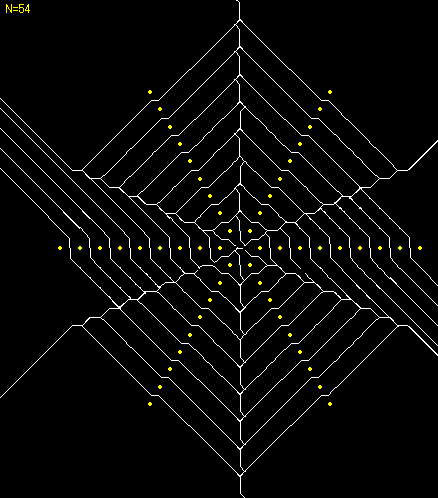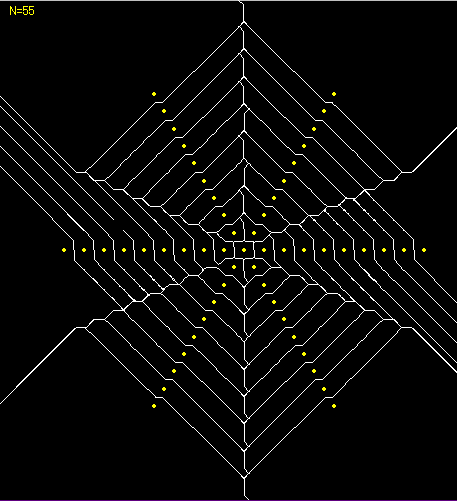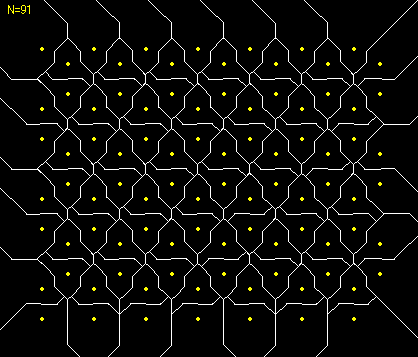CW, LW and Karlsruhe are very heavy.
Supremum-metric Voronoi diagram(Open 5/Sep/2000 : The 4th Revision Thursday, 03-Jun-2010 22:12:50 JST)
Supremum-metric Voronoi diagram is drawn by using distance function d(p,p(i))
d(p,p(i))=max{x-x(i)|,|y-y(i)|}
where (x,y) is the coordinate of p, (x(i),y(i)) is the coordinate of p(i), |a| is a sign of absolute value.
Special cases
 Supremum-metric Voronoi diagram for square lattice generators
Supremum-metric Voronoi diagram for square lattice generators
 Supremum-metric Voronoi diagram for radial generators 1
Supremum-metric Voronoi diagram for radial generators 1
 Supremum-metric Voronoi diagram for radial generators 2
Supremum-metric Voronoi diagram for radial generators 2
 Supremum-metric Voronoi diagram for triangular lattice generators
Supremum-metric Voronoi diagram for triangular lattice generators
 Supremum-metric Voronoi diagram for hexagonal lattice generators
Supremum-metric Voronoi diagram for hexagonal lattice generators
Algorithm
the concept is very close to that of the ordinary Voronoi diagram
Following algorithm is for the ordinary Voronoi diagram
i=1,...,N-1
j=i+1,...,N
Consider a bisector of p(i) and p(j)
k=1,...,N except for i and j
Consider a bisector of p(i) and p(k)
Calculate the points of intersection of bisector(i,j) and bisector(i,k)
next k
Add the points at x=0 and x=(the width of the screen) of the bisector of i and j into the points of intersections
Sort the points of intersections in terms of x coordinates
k=1,...,the number of intervals of the points of intersections
Let c be a midpoint of the interval of the points of intersection.
Let d be d(c,p(i))
h=1,...,N except for i and j
Let d' be d(c,p(h))
If d'<d then shout (Out!)
next h
If we did not shout, then draw the interval of the points of intersection
next k
next j
next i
but the bisector of supremum-metric Voronoi diagram is not line.
it is conbination of diagonal half-line, horizontal line segment and diagonal half-line (type 1) or
diagonal half-line, vertical line segment and diagonal half-line (type 2)
(See Okabe et al. Soatial tessellations 2nd ed. Fig. 3.7.4)
this conbination type is decided by the difference of x-coordinate and difference of y-coordinate.
that is, if difference of x-coordinates is larger than the difference of y-coordinates then type 2 and
if difference of y-coordinates is larger than the difference of x-coordinates then type 1
(I don't consider the case that the differences are exactly same because the probability is 0 since generators are made from random variables.)
By the way, I set y=400 x+? instead of the vertical line segment (x=?) of the type-2, sorry.
Java(supr.java)
If you have a message, don't hesitate to send it by using
E-mail: Mail Form
Mail Form
or
BBS
Use of Takashi Ohyama's website
English Home of Takashi Ohyama
Japanese Home of Takashi Ohyama
 Supremum-metric Voronoi diagram for square lattice generators
Supremum-metric Voronoi diagram for square lattice generators Supremum-metric Voronoi diagram for radial generators 1
Supremum-metric Voronoi diagram for radial generators 1 Supremum-metric Voronoi diagram for radial generators 2
Supremum-metric Voronoi diagram for radial generators 2 Supremum-metric Voronoi diagram for triangular lattice generators
Supremum-metric Voronoi diagram for triangular lattice generators Supremum-metric Voronoi diagram for hexagonal lattice generators
Supremum-metric Voronoi diagram for hexagonal lattice generators Mail Form
Mail Form